Comparative Analysis of Machine Learning Approaches to Predict Impact Energy of Hydraulic Breakers
Abstract
:1. Introduction
2. Materials and Methodology of Research
2.1. Research Area and Acquired Data Set
2.2. Selection of Methods for Sensitivity Testing of Predictive Models
2.3. Select Input Data for Sensitivity Test
- The coefficient of determination R2 is a comparison index between the predicted value and the actual value; that is, the measured performance index, the impact energy value, and a high R2 value indicates good model performance.
- Mean absolute error (MAE) measures the accuracy of two continuous variables: predicted and true. The average absolute error value was obtained using the following equation and was used to evaluate the model:
- The root-mean-square error (RMSE) is the observation and prediction of the ith step, where and are the predicted and true values, respectively. This serves as a measure of the RMSE residual error and is used to evaluate the model, which is essential for representing the output unit error. The root-mean-square error is determined using the following equation:
- The relative absolute error (RAE) represents the relative absolute error between the predicted and actual values and is a normalized value obtained by dividing the total absolute error by the total absolute error of the simple predictor. In this study, for reference, the relative absolute error was calculated as follows:
- The relative square error (RSE) is a normalized value obtained by dividing the total square error of the predicted value and the actual value by the total square error of the simple predictor and is used in the evaluation of the final selection model. The relative squared error was determined using the following equation:
2.4. Comparison of Uncertainty Analysis of the Final Selected Model
2.5. Confidence Interval Calculation of Best-Selected Model
3. Research Results and Discussion
3.1. Pearson Correlation Coefficient of the Acquired Data Set
3.2. Performance Modeling for Each Group of Acquired Data
3.3. Uncertainty Analysis of Neural Network Min–Max Normalize (NN-MM) Model
3.4. Confidence Interval Analysis
4. Conclusions
Author Contributions
Funding
Institutional Review Board Statement
Informed Consent Statement
Data Availability Statement
Conflicts of Interest
References
- Construction Industry Manufacturers Association (CIMA). Measuring Guide for Tool Energy Rating for Hydraulic Breakers; Milwaukee: Brookfield, WI, USA, 1996. [Google Scholar]
- Korean Agency for Technology and Standards (KATS). Hydraulic Breaker for Construction Machinery—RS B 0022; KATS: Eumseong, Republic of Korea, 2009.
- Baek, M.H.; Kim, S.H.; Park, J.W.; Lee, G.-S. A Study on the Wear Characteristics of Hydraulic Breaker System Tool Materials. Trans. Korean Soc. Mech. Eng. 2021, 21RE-Th03P40. Available online: https://www.dbpia.co.kr/journal/articleDetail?nodeId=NODE10556083 (accessed on 15 October 2022).
- Kim, S.H.; Chang, M.S.; Park, J.W.; Choi, B.O. A study on the degradation characteristic of a hydraulic breaker by the accelerated life testing of vertical impact operation. Trans. Korean Soc. Mech. Eng. 2013, 13RE-Th01P012. [Google Scholar]
- Kim, S.-H.; Park, J.-W.; Chang, M.-S.; Kim, J.-H. Study on fatigue life prediction of vibro-hammer structure using field data. Trans. Korean Soc. Mech. Eng. A 2019, 43, 811–820. [Google Scholar] [CrossRef]
- Kim, S.H.; Park, J.W.; Choi, B.O.; Lee, Y.B.; Kim, D.S.; Choi, J.S.; Yu, H.S.; Lee, G.S.; Yang, C.G. Apparatus for Static Load Testing of Hydraulic Breaker Chisel. Patent No. 10-1501116, 4 March 2015. [Google Scholar]
- Park, J.W.; Kim, S.H.; Choi, B.O.; Back, D.C. Pin Fixed Type Apparatus for Testing of Hydraulic Breaker. Patent No. 10-1453928, 16 October 2014. [Google Scholar]
- Park, J.W.; Kim, S.H.; Choi, B.O.; Back, D.C.; Km, N.G. Apparatus for Testing of Hydraulic Breaker. Patent No. 10-1452901, 14 October 2014. [Google Scholar]
- Kim, S.H.; Park, J.W.; Kim, J.H. A Study on Expanded Uncertainty of Hydraulic Breakers Impact Energy Test. Trans. Korean Soc. Mech. Eng. 2018, 18RE-Th01P021. Available online: https://www.dbpia.co.kr/journal/articleDetail?nodeId=NODE07397536 (accessed on 15 October 2022).
- Kim, S.-H.; Park, J.-W.; Kim, J.-H. Functional data analysis for assessing the fatigue life of construction equipment attachments. J. Mech. Sci. Technol. 2021, 35, 495–506. [Google Scholar] [CrossRef]
- Yin, X.; Yin, S.; Zhu, H.; Zhang, Z. Experimental Study on Constant Speed Control Technology of Hydraulic Drive Pavers. Processes 2023, 11, 477. [Google Scholar] [CrossRef]
- Liu, L.; Awwad, E.M.; Ali, Y.A.; Al-Razgan, M.; Maarouf, A.; Abualigah, L.; Hoshyar, A.N. Multi-Dataset Hyper-CNN for Hyperspectral Image Segmentation of Remote Sensing Images. Processes 2023, 11, 435. [Google Scholar] [CrossRef]
- Kim, S.H.; Chung, J.; Baek, D.C.; Park, J.W. Modeling and Simulation for Predicting the Impact of Hydraulic Breaker. J. Korea Acad.-Ind. Coop. Soc. 2019, 20, 741–749. [Google Scholar]
- Krishnamoorthy, K.; Peng, J. Some Properties of the Exact and Score Methods for Binomial Proportion and Sample Size Calculation. Commun. Stat.-Simul. Comput. 2007, 36, 1171–1186. [Google Scholar] [CrossRef]
- Jay, D. Probability and Statistics for Engineering and the Sciences, 3rd ed.; Brooks/Cole Publishing Company, A Division of Wadsworth: Belmont, CA, USA, 1991; pp. 268–269. [Google Scholar]
- Borda, D.; Bergagio, M.; Amerio, M.; Masoero, M.C.; Borchiellini, R.; Papurello, D. Development of Anomaly Detectors for HVAC Systems Using Machine Learning. Processes 2023, 11, 535. [Google Scholar] [CrossRef]
- Alimissis, A.; Philippopoulos, K.; Tzanis, C.G.; Deligiorgi, D. Spatial estimation of urban air pollution with the use of artificial neural network models. Atmos. Environ. 2018, 191, 205–213. [Google Scholar] [CrossRef]
- Fromm, R.; Schönberger, C. Estimating the danger of snow avalanches with a machine learning approach using a comprehensive snow cover model. Mach. Learn. Appl. 2022, 10, 100405. [Google Scholar] [CrossRef]
- Noori, R.; Hoshyaripour, G.; Ashrafi, K.; Araabi, B.N. Uncertainty analysis of developed ANN and ANFIS models in prediction of carbon monoxide daily concentration. Atmos. Environ. 2010, 44, 476–482. [Google Scholar] [CrossRef]
- Ali, Y.A.; Awwad, E.M.; Al-Razgan, M.; Maarouf, A. Hyperparameter Search for Machine Learning Algorithms for Optimizing the Computational Complexity. Processes 2023, 11, 349. [Google Scholar] [CrossRef]
- Chowdhury, T.; Wang, Q. Study on Thermal Degradation Processes of Polyethylene Terephthalate Microplastics Using the Kinetics and Artificial Neural Networks Models. Processes 2023, 11, 496. [Google Scholar] [CrossRef]
- Cristea, V.-M.; Baigulbayeva, M.; Ongarbayev, Y.; Smailov, N.; Akkazin, Y.; Ubaidulayeva, N. Prediction of Oil Sorption Capacity on Carbonized Mixtures of Shungite Using Artificial Neural Networks. Processes 2023, 11, 518. [Google Scholar] [CrossRef]

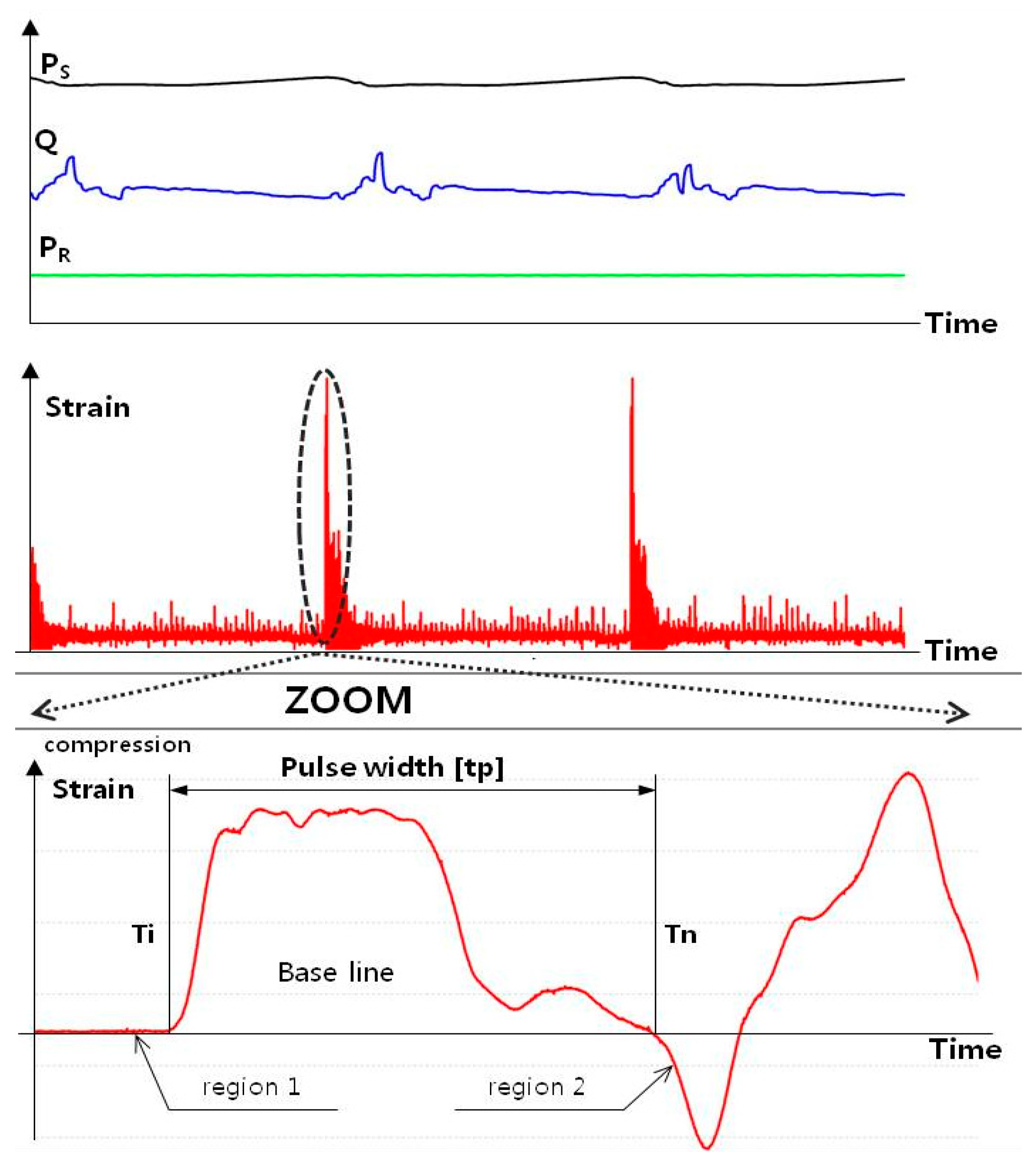
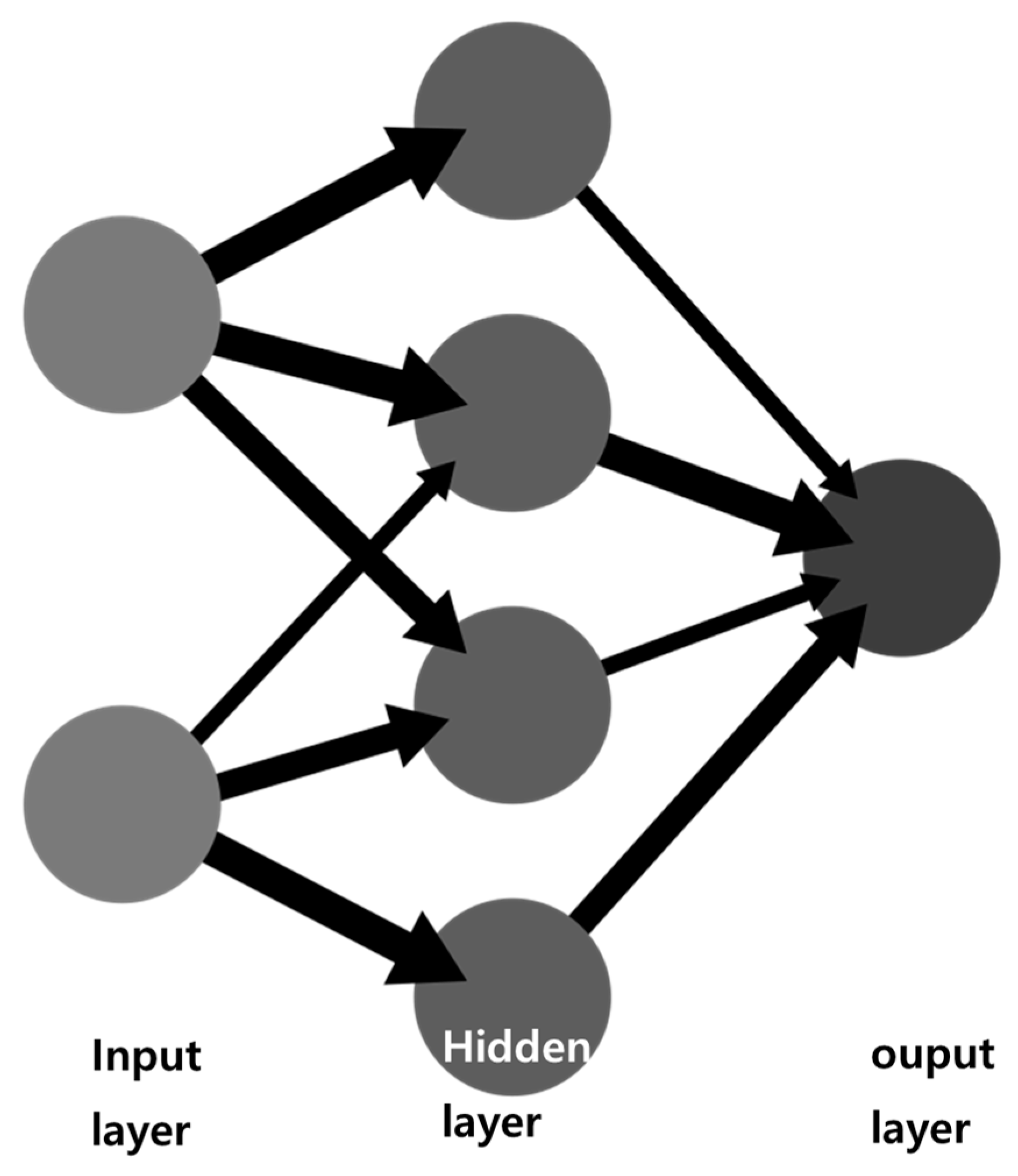
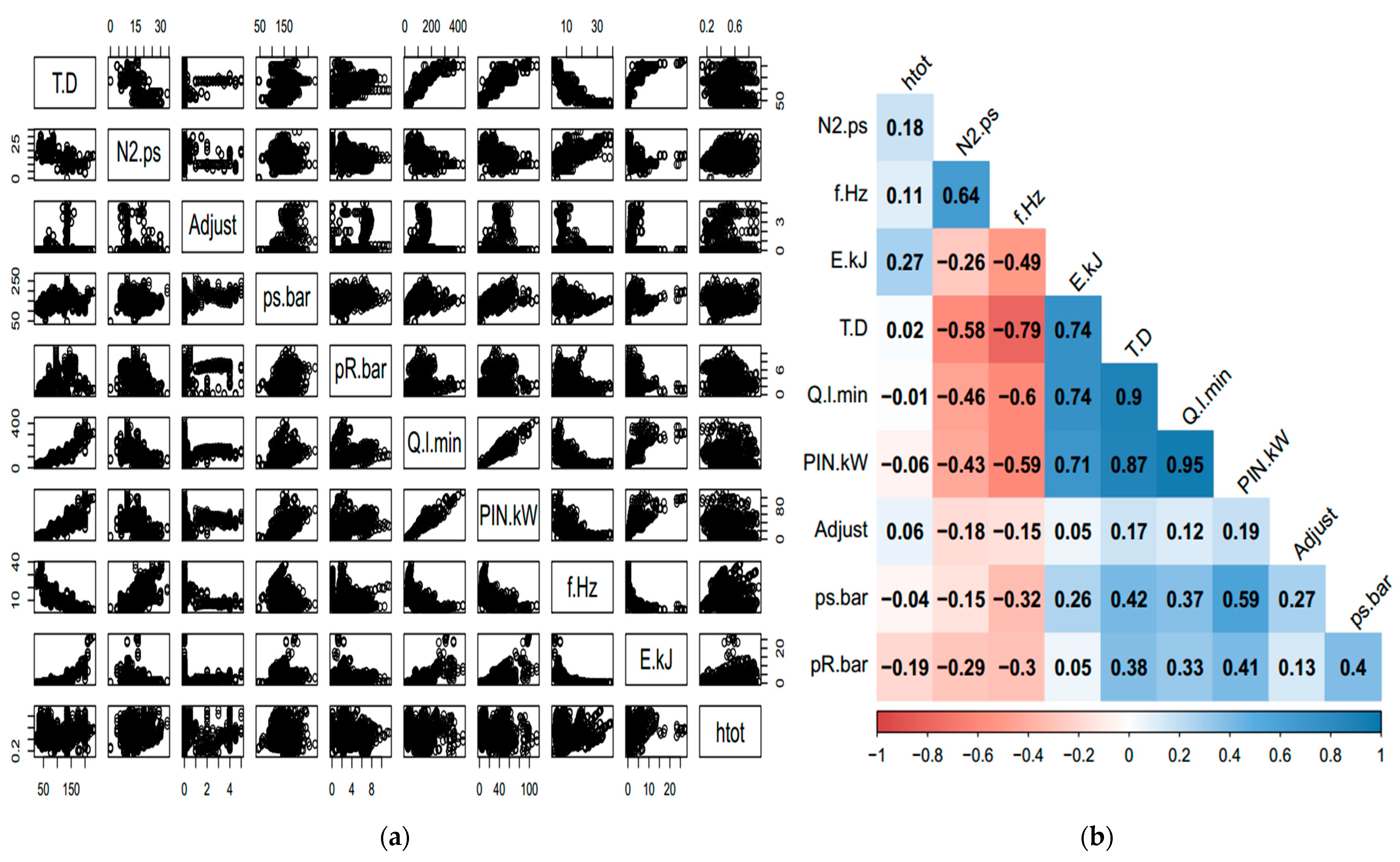

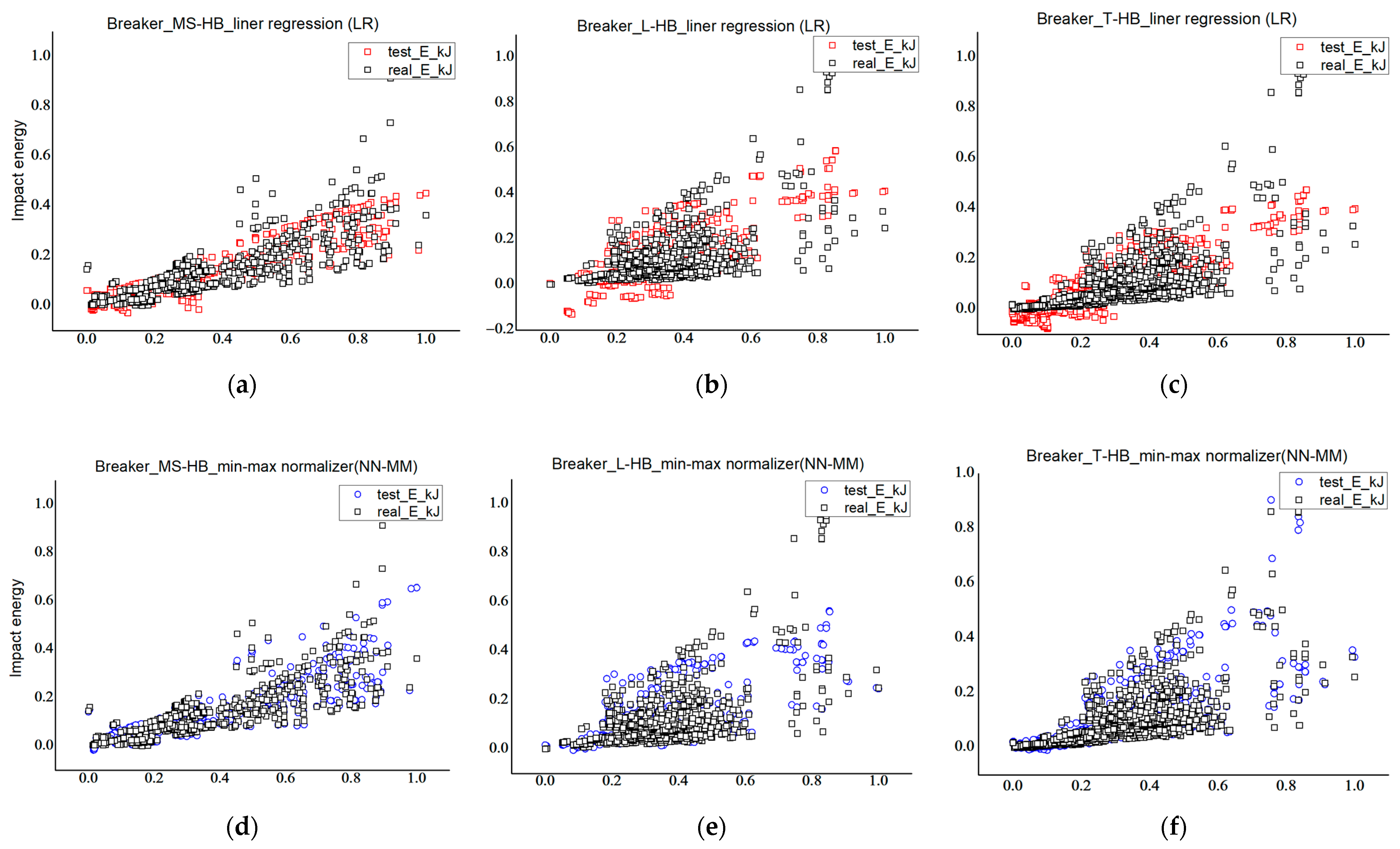

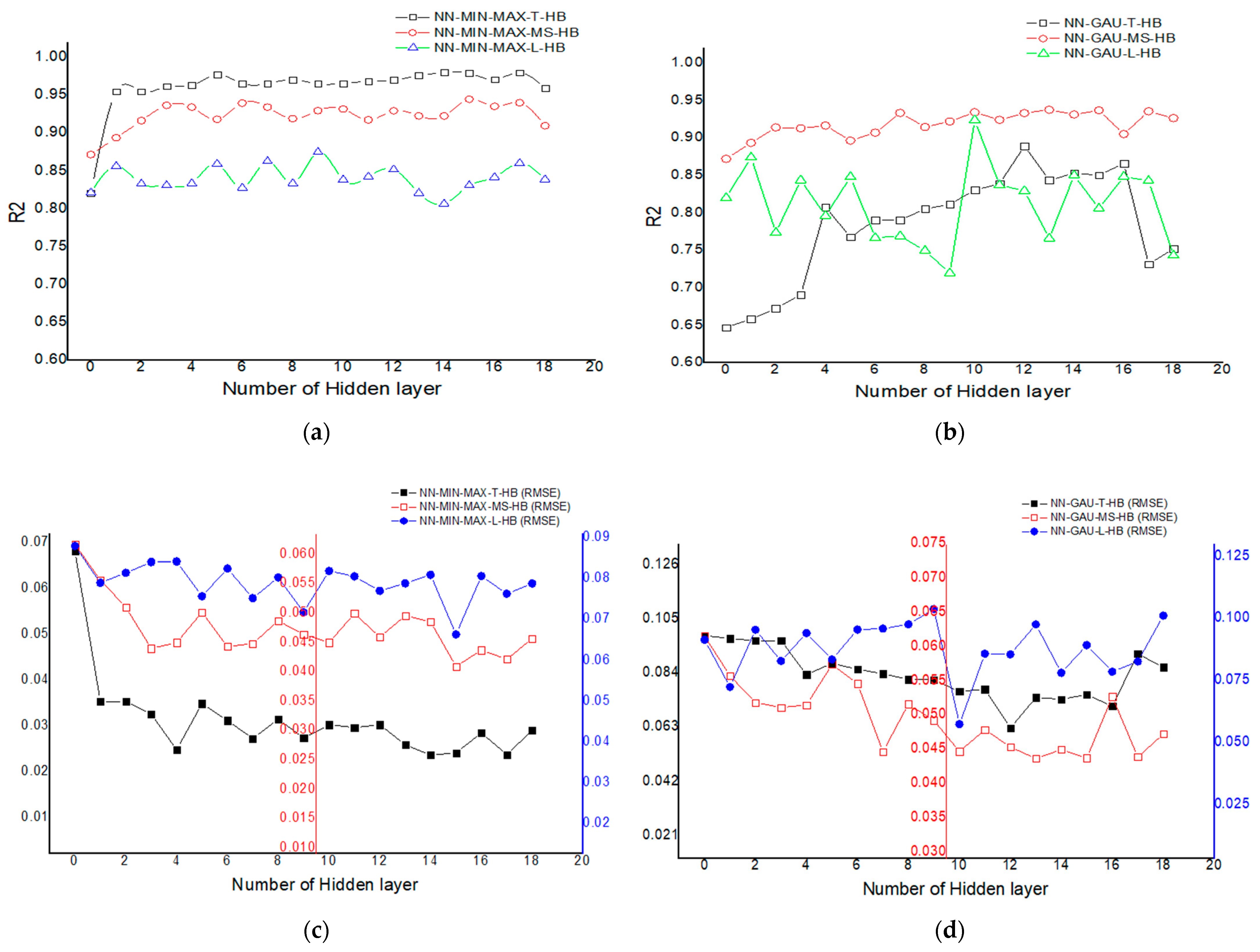
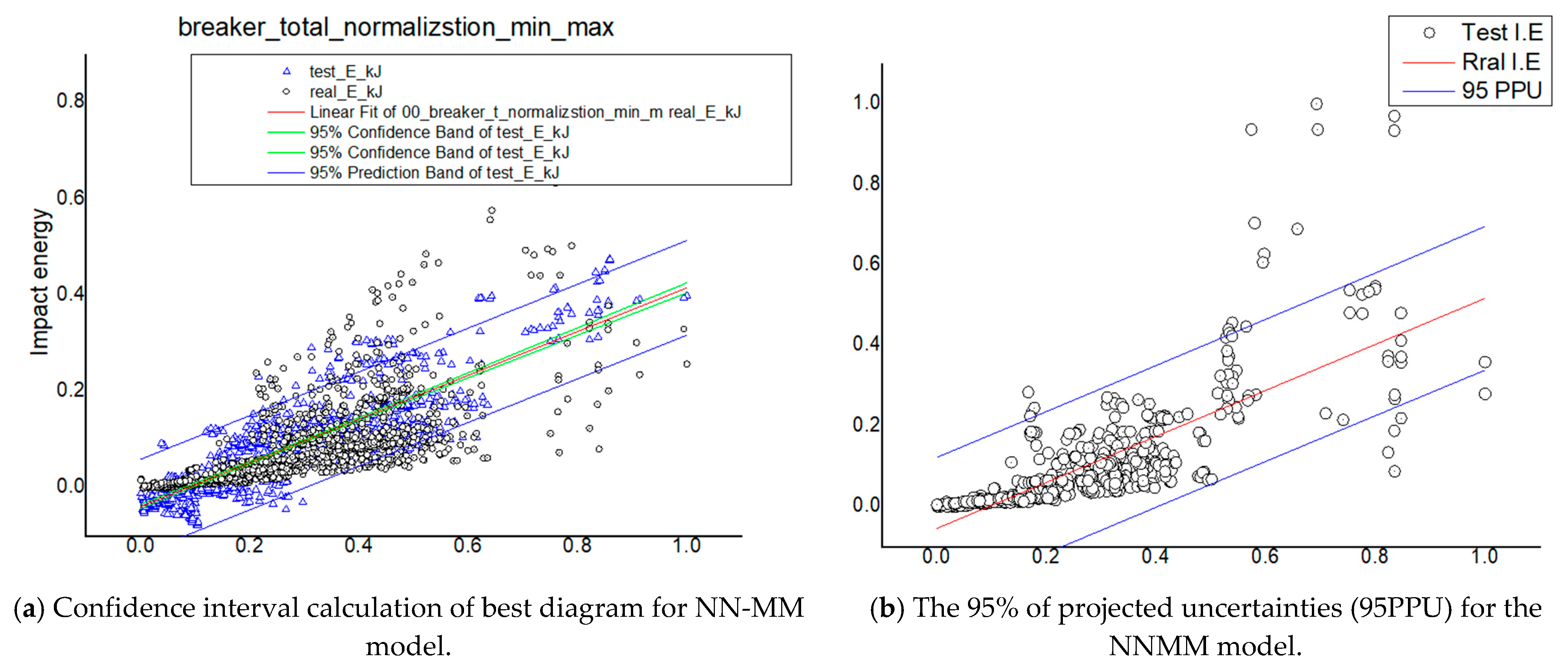

| T-D [mm] | N2/ps [kg/cm2] | Adjust valve | ps/bar [bar] | pR/bar [bar] | Q/l/min [lpm] | PIN/kW [kw] | f/Hz [hz] | E/kJ 1 [k J] |
|---|---|---|---|---|---|---|---|---|
| … | … | … | … | … | … | … | … | … |
| 100 | 6.5 | 0 | 137.203 | 6.712 | 55.622 | 12.722 | 7.300 | 1.164 |
| 100 | 6.5 | 0 | 137.212 | 7.457 | 56.464 | 12.915 | 7.249 | 1.171 |
| 100 | 6.5 | 0 | 125.425 | 6.817 | 51.614 | 11.806 | 6.626 | 1.071 |
| 100 | 6.5 | 0 | 150.007 | 0.57 | 73.84 | 20.696 | 6.554 | 1.352 |
| 100 | 6.5 | 0 | 153.695 | 0.584 | 75.656 | 21.205 | 6.715 | 1.385 |
| … | … | … | … | … | … | … | … | … |
| 135 | 10 | 3.25 | 166.967 | 7.063 | 167.5 | 51.002 | 7.698 | 2.889 |
| 135 | 10 | 0 | 179.387 | 6.537 | 178.042 | 58.244 | 7.948 | 2.897 |
| 135 | 10 | 3.5 | 165.602 | 6.95 | 163.757 | 49.454 | 7.703 | 2.922 |
| 135 | 16 | 0 | 181.236 | 3.61 | 161.213 | 53.283 | 9.599 | 2.995 |
| 135 | 16 | 0 | 161.829 | 4.113 | 99.535 | 29.375 | 5.010 | 2.997 |
| … | … | … | … | … | … | … | … | … |
| 155 | 6 | 0 | 196.968 | 6.943 | 224.258 | 73.634 | 14.202 | 1.732 |
| 155 | 14 | 0.25 | 157.714 | 7.351 | 215.449 | 56.643 | 10.52 | 1.869 |
| 155 | 14 | 0.25 | 153.801 | 7.517 | 213.846 | 54.827 | 10.298 | 1.927 |
| 155 | 10 | 0 | 191.928 | 7.933 | 217.399 | 69.555 | 12.52 | 2.144 |
| 155 | 10 | 0 | 194.562 | 7.396 | 218.438 | 70.847 | 12.298 | 2.205 |
| … | … | … | … | … | … | … | … | … |
| 220 | 16 | 0 | 190.616 | 1.363 | 301.573 | 96.186 | 2.627 | 25.359 |
| 220 | 15.55 | 0 | 193.592 | 1.157 | 308.535 | 98.074 | 2.229 | 25.796 |
| 220 | 16 | 0 | 193.616 | 1.158 | 308.573 | 98.086 | 2.827 | 25.799 |
| 230 | 16 | 0 | 195.462 | 1.268 | 312.535 | 99.074 | 2.240 | 26.898 |
| 230 | 16.5 | 0 | 195.616 | 1.258 | 312.574 | 99.086 | 2.237 | 26.972 |
| … | … | … | … | … | … | … | … | … |
| T-D [mm] | N2/ps [kg/cm2] | Adjust valve | ps/bar [bar] | pR/bar [bar] | Q/l/min [lpm] | PIN/kW [kw] | f/Hz [hz] | E/kJ 1 [k J] |
|---|---|---|---|---|---|---|---|---|
| … | … | … | … | … | … | … | … | … |
| 25 | 16 | 0 | 105.641 | 0.052 | 21.956 | 6.250 | 21.791 | 0.416 |
| 25 | 16 | 0 | 117.379 | 0.058 | 24.395 | 6.945 | 24.212 | 0.371 |
| 30 | 17 | 0 | 111.995 | 0.089 | 29.085 | 7.231 | 24.593 | 0.817 |
| 30 | 18 | 0 | 122.788 | 0.097 | 31.887 | 7.928 | 26.964 | 0.896 |
| 30 | 17 | 0 | 121.580 | 0.125 | 29.221 | 7.126 | 28.931 | 0.970 |
| … | … | … | … | … | … | … | … | … |
| 50 | 14 | 0 | 134.162 | 0.095 | 18.827 | 4.241 | 11.631 | 3.350 |
| 50 | 16 | 0.25 | 134.163 | 0.085 | 18.838 | 4.250 | 11.922 | 3.366 |
| 50 | 15 | 0 | 134.743 | 0.087 | 18.920 | 4.269 | 11.974 | 3.376 |
| 50 | 14 | 0 | 135.344 | 0.085 | 19.004 | 4.288 | 12.027 | 3.391 |
| 50 | 15 | 0 | 135.929 | 0.086 | 19.086 | 4.306 | 12.079 | 3.405 |
| … | … | … | … | … | … | … | … | … |
| 80 | 14 | 0 | 156.378 | 2.787 | 66.335 | 17.292 | 12.639 | 4.998 |
| 80 | 13 | 0.5 | 138.297 | 0.116 | 101.453 | 23.389 | 19.432 | 5.002 |
| 80 | 16 | 0 | 167.263 | 2.858 | 59.226 | 16.514 | 12.590 | 5.476 |
| 80 | 17 | 0 | 136.350 | 0.104 | 95.959 | 21.811 | 20.341 | 5.723 |
| 80 | 16 | 0 | 164.464 | 2.361 | 60.966 | 16.714 | 12.488 | 5.724 |
| … | … | … | … | … | … | … | … | … |
| 95 | 14 | 0.5 | 146.140 | 8.652 | 89.426 | 23.833 | 18.079 | 6.169 |
| 95 | 16 | 0.5 | 143.905 | 8.736 | 91.242 | 23.945 | 18.218 | 6.481 |
| 95 | 14 | 0.5 | 155.947 | 10.506 | 101.611 | 28.897 | 19.349 | 6.547 |
| 95 | 16 | 0.5 | 168.624 | 10.138 | 104.425 | 32.112 | 19.714 | 7.271 |
| 95 | 14 | 0 | 156.045 | 7.452 | 98.351 | 27.988 | 12.722 | 8.234 |
| … | … | … | … | … | … | … | … | … |
| T-D | N2/ps | Adjust | ps/bar | pR/bar | Q/l/min | PIN/kW | f/Hz | E/kJ | ||
|---|---|---|---|---|---|---|---|---|---|---|
| Small and medium-class of hydraulic breaker (MS-HB) | MEAN 1 | 65.163 | 18.587 | 0.096 | 138.424 | 2.049 | 53.578 | 13.802 | 16.705 | 4.360 |
| STDEV 2 | 19.093 | 4.627 | 0.282 | 27.334 | 1.776 | 28.502 | 8.355 | 7.085 | 3.300 | |
| MIN | 56.799 | 13.000 | 0.000 | 56.799 | 0.052 | 10.683 | 1.306 | 5.687 | 0.371 | |
| MAX | 212.468 | 34.000 | 2.000 | 212.468 | 11.494 | 131.001 | 35.882 | 38.820 | 17.400 | |
| MEDN 3 | 70.000 | 16.000 | 0.000 | 139.040 | 2.029 | 47.006 | 11.916 | 14.953 | 3.438 | |
| Large-class of hydraulic breaker (L-HB) | MEAN | 142.878 | 12.420 | 0.658 | 167.581 | 4.362 | 159.272 | 45.898 | 6.927 | 3.735 |
| STDEV | 25.011 | 3.854 | 1.370 | 28.322 | 2.500 | 61.848 | 16.968 | 2.360 | 3.679 | |
| MIN | 100.000 | 0.000 | 0.000 | 42.969 | 0.074 | 49.624 | 5.642 | 1.938 | 0.334 | |
| MAX | 230.000 | 23.000 | 5.000 | 278.434 | 10.582 | 435.952 | 115.255 | 16.631 | 27.102 | |
| MEDN | 135.000 | 12.000 | 0.000 | 170.575 | 4.851 | 149.590 | 44.390 | 7.042 | 2.685 |
| Testing Algorithm | T-HB | MS-HB | L-HB | |||
|---|---|---|---|---|---|---|
| R2 | RMSE | R2 | RMSE | R2 | RMSE | |
| Linear regression (LR) | 0.82067 | 0.06812 | 0.88079 | 0.05861 | 0.84111 | 0.07434 |
| Neural network: min–max normalize (NN-MM) | 0.98023 | 0.02359 | 0.94510 | 0.04093 | 0.89130 | 0.06633 |
| Neural network: Gaussian normalize (NN-GAU) | 0.88959 | 0.06272 | 0.93796 | 0.04366 | 0.92404 | 0.40246 |
Disclaimer/Publisher’s Note: The statements, opinions and data contained in all publications are solely those of the individual author(s) and contributor(s) and not of MDPI and/or the editor(s). MDPI and/or the editor(s) disclaim responsibility for any injury to people or property resulting from any ideas, methods, instructions or products referred to in the content. |
© 2023 by the authors. Licensee MDPI, Basel, Switzerland. This article is an open access article distributed under the terms and conditions of the Creative Commons Attribution (CC BY) license (https://creativecommons.org/licenses/by/4.0/).
Share and Cite
Kim, S.-H.; Park, J.-W.; Kim, J.-H. Comparative Analysis of Machine Learning Approaches to Predict Impact Energy of Hydraulic Breakers. Processes 2023, 11, 772. https://doi.org/10.3390/pr11030772
Kim S-H, Park J-W, Kim J-H. Comparative Analysis of Machine Learning Approaches to Predict Impact Energy of Hydraulic Breakers. Processes. 2023; 11(3):772. https://doi.org/10.3390/pr11030772
Chicago/Turabian StyleKim, Sung-Hyun, Jong-Won Park, and Jae-Hoon Kim. 2023. "Comparative Analysis of Machine Learning Approaches to Predict Impact Energy of Hydraulic Breakers" Processes 11, no. 3: 772. https://doi.org/10.3390/pr11030772







